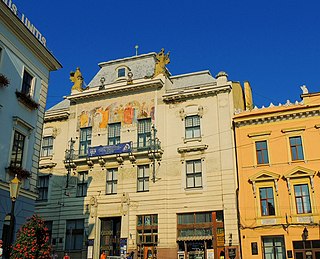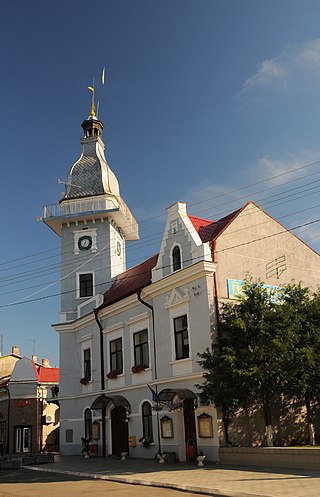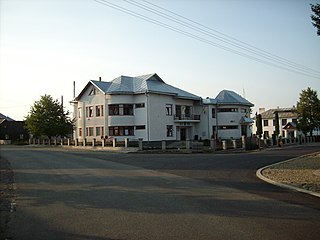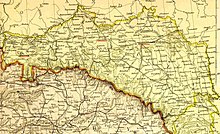
Bukovina is a historical region, variously described as part of either Central or Eastern Europe. The region is located on the northern slopes of the central Eastern Carpathians and the adjoining plains, today divided between Romania and Ukraine.

Chernivtsi Oblast, also referred to as Chernivechchyna (Чернівеччина), is an oblast (province) in western Ukraine, consisting of the northern parts of the historical regions of Bukovina and Bessarabia. It has an international border with Romania and Moldova. The region spans 8,100 square kilometres (3,100 sq mi). The oblast is the smallest in Ukraine both by area and population. It has a population of 890,457, and its administrative center is the city of Chernivtsi.

Chernivtsi is a city in southwestern Ukraine on the upper course of the Prut River. Formerly the capital of the historic region of Bukovina, which is now divided between Romania and Ukraine, Chernivtsi serves as the administrative center for the Chernivtsi Raion, the Chernivtsi urban hromada, and the oblast itself. In 2022, the Chernivtsi population, by estimate, is 264,298, and the latest census in 2001 was 240,600.

Suceava is a municipality and the namesake county seat town of Suceava County, situated in the historical regions of Bukovina and Moldavia, northeastern Romania and at the crossroads of Central and Eastern Europe respectively. It is the largest urban settlement of Suceava County, with a population of 84,308 inhabitants according to the 2021 Romanian census.

Ternopil Oblast, also referred to as Ternopilshchyna or Ternopillia, is an oblast (province) of Ukraine. Its administrative center is Ternopil, through which flows the Seret, a tributary of the Dniester. Population: 1,021,713.

The Kingdom of Galicia and Lodomeria, also known as Austrian Galicia or colloquially Austrian Poland, was a constituent possession of the Habsburg monarchy in the historical region of Galicia in Eastern Europe. The crownland was established in 1772. The lands were annexed from the Polish-Lithuanian Commonwealth as part of the First Partition of Poland. In 1804 it became a crownland of the newly proclaimed Austrian Empire. From 1867 it was a crownland within the Cisleithanian or Austrian half of the dual monarchy of Austria-Hungary. It maintained a degree of provincial autonomy. Its status remained unchanged until the dissolution of the monarchy in 1918.

Rădăuți is a town in Suceava County, north-eastern Romania. It is situated in the historical region of Bukovina. According to the 2021 census, Rădăuți is the second largest urban settlement in the county. It was declared a municipality in 1995, along with two other cities in Suceava County: Fălticeni and Câmpulung Moldovenesc. Rădăuți covers an area of 32.30 km2 (12.47 sq mi) and it was the capital of former Rădăuți County.

The Duchy of Bukovina was a constituent land of the Austrian Empire from 1849 and a Cisleithanian crown land of Austria-Hungary from 1867 until 1918.

Siret is a town, municipality and former Latin bishopric in Suceava County, northeastern Romania. It is situated in the historical region of Bukovina. Siret is the 11th largest urban settlement in the county, with a population of 6,708 inhabitants, according to the 2021 census. It is one of the oldest towns in Romania and was the capital of the medieval Principality of Moldavia during the late 14th century. Furthermore, the town administers two villages: Mănăstioara and Pădureni.

Western Ukraine or West Ukraine refers to the western territories of Ukraine. There is no universally accepted definition of the territory's boundaries, but the contemporary Ukrainian administrative regions (oblasts) of Chernivtsi, Ivano-Frankivsk, Lviv, Ternopil and Zakarpattia are typically included. In addition, Volyn and Rivne Oblasts are also usually included. It is less common to include the Khmelnytskyi Oblasts in this category. It includes several historical regions such as Carpathian Ruthenia, Halychyna including Pokuttia, most of Volhynia, northern Bukovina and the Hertsa region, and Podolia. Western Ukraine is sometimes considered to include areas of eastern Volhynia, Podolia, and the small northern portion of Bessarabia.

Chernivtsi National University is a public university in the City of Chernivtsi in Western Ukraine. One of the leading Ukrainian institutions for higher education, it was founded in 1875 as the Franz-Josephs-Universität Czernowitz when Chernivtsi (Czernowitz) was the capital of the Duchy of Bukovina, a Cisleithanian crown land of Austria-Hungary. Today the university is based at the Residence of Bukovinian and Dalmatian Metropolitans building complex, a UNESCO World Heritage Site since 2011.

Storozhynets is a small city located in Chernivtsi Raion, Chernivtsi Oblast of western Ukraine, north of the border with Romania. It hosts the administration of Storozhynets urban hromada, one of the hromadas of Ukraine. It is located approximately 20 km (12 mi) south-west of the oblast capital, Chernivtsi. Population: 14,077.

Kitsman is a city located in Chernivtsi Raion, Chernivtsi Oblast, in the historical region of Bukovina of western Ukraine. It hosts the administration of Kitsman urban hromada, one of the hromadas of Ukraine. The town is about 20 km (12 mi) northwest from Chernivtsi on the road to Zalishchyky. Population: 6,049.

The Bukovina Germans, also known and referred to as Buchenland Germans, or Bukovinian Germans, are a German ethnic group which settled in Bukovina, a historical region situated at the crossroads of Central and Eastern Europe, during the modern period. They are part of the larger group of Romanian Germans since the early 20th century, when they were initially living in the Kingdom of Romania.

Dornești is a commune located in Suceava County, in the historical region of Bukovina, northeastern Romania. It is composed of two villages, Dornești and Iaz. From 1786 to 1941, the village of Dornești was inhabited by the Székelys of Bukovina. In the past, the commune was also inhabited by a German minority, more specifically Bukovina Germans. Nowadays, the vast majority of the population are ethnic Romanians.

Frătăuții Vechi is a commune located in Suceava County, Bukovina, northeastern Romania. It is composed of two villages: namely Frătăuții Vechi and Măneuți.

Benno or Beno Straucher was a Bukovina-born Austro-Hungarian lawyer, politician and Jewish community representative, who spent the final part of his career in Romania. A Jewish nationalist influenced by classical liberalism and Zionism, he first held political offices in Czernowitz city. After 1897, he was one of the noted Jewish representatives in the Austrian Parliament's upper chamber (Abgeordnetenhaus). Straucher, who was instrumental in creating the reformist Progressive Peasants' Fellowship, maintained his Abgeordnetenhaus seat throughout the remainder of Austria-Hungary's existence. From 1906, he led the Jewish National People's Party locally and helped establish the pan-Austrian Jewish National Party. He vied for political direction over the Bukovina Jews with several other groups, most notably the Zionist People's Council Party of Mayer Ebner, who became his personal rival.

FreiherrAlexander Wassilko von Serecki was an Austro-Hungarian ethnic Romanian statesman, Landeshauptmann of the Duchy of Bukovina and member of the Herrenhaus, the Upper House of the Imperial Council of Austria.

Ițcani is a neighbourhood of Suceava, the county seat town of Suceava County in the historical region of Bukovina, northeastern Romania, located some 5 km northwest of the town center. Ițcani was initially established in the 15th century, following a 1453 document issued by Alexăndrel, Domn of Moldavia.

Shepit is a village in Vyzhnytsia Raion, Chernivtsi Oblast, Ukraine. It belongs to Seliatyn rural hromada, one of the hromadas of Ukraine. Population: 683.























